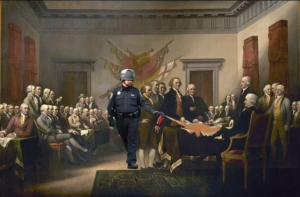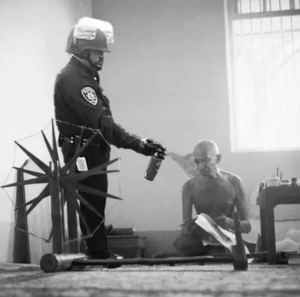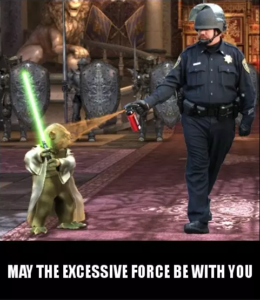Minds of the Movement
An ICNC blog on the people and power of civil resistance
by Lee A. Smithey and Lester R. KurtzNovember 05, 2018
On November 18, 2011, students at the University of California at Davis (USA) nonviolently occupied a sidewalk as part of a campaign across the UC system to protest tuition hikes and cuts to university funding. A few days earlier, police had used batons on students and faculty at another campus, the University of California at Berkeley, and had torn down a tent encampment similar to that at UC Davis.
Videos show UC Davis campus and local police wearing riot gear and apparently carrying paintball guns that could fire pepper spray projectiles. As students sat with their arms linked together and refused to move from a sidewalk, campus police lieutenant John Pike doused the activists at close range with high-strength pepper spray in front of a large crowd of onlooking students. Many present recorded the event, and a video of the attack went viral, provoking public outrage in the form of satirical internet memes, a popular petition, and further student protest.
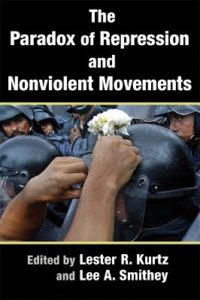 This is the paradox of repression that we and our colleagues explore in an edited volume titled The Paradox of Repression and Nonviolent Movements (Syracuse University Press, 2018). It is a fundamental dynamic of nonviolent civil resistance also called “backfire” and “political jiu-jitsu.” In the most clear examples of the paradox, when authorities, elites, or counter protesters use physical force to try to demobilize nonviolent activists, images of beatings, arrests, attack dogs, water hoses, and assassinations can generate moral outrage that can lead to heightened mobilization and support for activists, and sometimes even defections by the supporters of the movement's opponent. When nonviolent activists maintain their nonviolent stance, they heighten the contrast between the violence of their opponents and their own actions, increasing the possibility that repression will backfire and authorities will lose legitimacy.
This is the paradox of repression that we and our colleagues explore in an edited volume titled The Paradox of Repression and Nonviolent Movements (Syracuse University Press, 2018). It is a fundamental dynamic of nonviolent civil resistance also called “backfire” and “political jiu-jitsu.” In the most clear examples of the paradox, when authorities, elites, or counter protesters use physical force to try to demobilize nonviolent activists, images of beatings, arrests, attack dogs, water hoses, and assassinations can generate moral outrage that can lead to heightened mobilization and support for activists, and sometimes even defections by the supporters of the movement's opponent. When nonviolent activists maintain their nonviolent stance, they heighten the contrast between the violence of their opponents and their own actions, increasing the possibility that repression will backfire and authorities will lose legitimacy.
The pepper-spray incident at UC Davis illustrates the paradox of repression in several ways. Foremost, the students sitting on the sidewalk on their own campus clearly demonstrated that they posed no threat to the police or others around them. So, when Lieutenant Pike deployed pepper spray to incapacitate them, a petition was launched to call for the Chancellor to resign, amassing some 115,000 signatures. Pepper-sprayed students sued the university and won a $1 million federal lawsuit settlement, along with a written apology from Chancellor Linda P.B. Katehi.
This incident also illustrates repression management, the efforts of nonviolent activists to increase the possibility that repressive measures will backfire. Using methods of nonviolent intervention by occupying the sidewalk was perhaps the first strategic act of anticipating repression, but then, once the campus security officer attacked the students, online activists worked to manage and frame the event to maximize its reach. In a fascinating example of cultural activism, visual memes proliferated across the internet. Images with Lieutenant Pike superimposed on top of them portrayed the police action as irresponsible, implying that it was absurd, heavy-handed, and un-American.
Cultivation of the backfire effect after the event reveals that repression is a powerful interaction. Nonviolent activists can make strategic choices that prepare for repression, but they also shape the impact of repression with their tactical choices. Video of the event shows the immediate outrage of bystanding students, who chanted “shame on you” and “who do you serve, who do you protect?”, framing the event as a violation of a social contract.
But an even more remarkable strategic act of repression management took place as the confrontation unfolded. As the police and security officers arrested students, the anger of the crowd grew. The outnumbered police officers became visibly nervous as they tried to back away from the crowd that surrounded them on three sides. They formed a circle with their backs to one another, and some began to raise their weapons slowly. The crowd grew louder, and one can sense the rising possibility of a confrontation. Would a police officer panic and pull a trigger? Would Lieutenant Pike use his pepper spray canisters again? Would someone in the crowd throw a water bottle and give the police the justification to use more physical force?
What had begun as strategic nonviolent action could have devolved into a violent confrontation. If the police were attacked or provoked, the important contrast between the police and the students could have been lost. The nonviolent protest of the students on the sidewalk could have been recast as a dangerous mob action, playing to law and order sensibilities among the general public. The possibility of the whole thing falling apart appears quite real. Until some leader brilliantly reorganized the crowd and clearly reasserted nonviolent discipline.
Around 6 minutes and 12 seconds into the video, someone yells “mic check!”, focusing the crowd’s attention and calling on them to participate in a human amplification system in which a crowd of people repeat after the speaker so that everyone can hear. The speaker (off-camera) yells to the police, “We are willing to give you a brief moment of peace. You may take your weapons and our friends and go. Please do not return.” Then, the crowd chants, “You can go! You can go!” The crowd finally leaves the police alone in a cluster, looking slightly bewildered and unsure, robbed of the kind of confrontation for which their training, armor, and weapons were designed. Instead of the police commanding the situation as the legitimate forces of law and order, suddenly students were giving the police permission to leave, reasserting their legitimacy as students on their own campus, shouting “Whose quad? Our quad!”
Nonviolent student activists at UC Davis chose to remain nonviolent in the face of repression. Their disciplined response to pepper-spraying helped to ensure that the police actions could be clearly interpreted as disproportionate, thus challenging the legitimacy of the police and even university administrators, as reported in the press. When the police action and the anger of the crowd threatened to provoke a violent confrontation, potentially justifying further repression, someone stepped up to manage the repression in real time and preserve the frame of excessive force that internet activists played up in the days and weeks that followed.
Instances of authorities overstepping the bounds of their legitimacy and using excessive force are common across the United States and around the world. The ability of nonviolent activists to prepare for repression and cultivate the paradox of repression through careful and creative planning is perhaps under-appreciated.
You can read a selection of cases in which the paradox of repression was at play by visiting the Global Nonviolent Action Database, and you can learn more about the paradox of repression and repression management in The Paradox of Repression and Nonviolent Movements, the research for which was supported by ICNC.
This article has also been translated into Spanish.
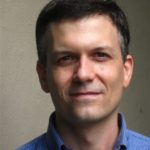
Lee A. Smithey
Lee A. Smithey serves as Coordinator of the Peace and Conflict Studies program at Swarthmore College, Pennsylvania, USA. He is associate professor in the same program and also serves as ICNC Academic Advisor. Previously, he served as Chair of the Peace, War, and Social Conflict section of the American Sociological Association.
Read More
Lester R. Kurtz
Lester R. Kurtz is professor of public sociology at George Mason University Korea, where he teaches peace and conflict studies, comparative sociology of religion, and social theory. He is a Distinguished Research Fellow at the Institute of Nanjing Massacre History and International Peace and an ICNC Academic Advisor.
Read More